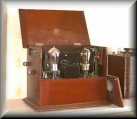DIRECTING THE ACTOR for radio drama
| KEY TERMS FOR ACTOR AND DIRECTOR |
| OBSTACLE (BELOW) |
| SUBTEXT - unspoken thoughts and motives under the dialogue - content underneath |
| 'CHOICES-OBJECTIVE' TECHNIQUE |
| CHOICES - you discover the different CHOICES for each line and phrase - the final CHOICE becomes the actor's OBJECTIVE |
| OBJECTIVE - What the character is trying to achieve at any one point or overall - the result of work on CHOICES |
| ADJUSTMENTS (BELOW) - new tactic by the character to gain the OBJECTIVE |
| ALSO NOTE - |
| COUGHS AND COLDS - a disaster possibly |
| Your work as a radio drama director - checklist - redrafting - preparation - good relations in the Studio - directing style - dangers |
PRODUCTION - team - working out of sequence - in studio- OB - check the actors
|
This gives you only the 'bullet points'. Learn about radio drama acting in my book - Beck, Alan, Radio Acting, London: A & C Black (1997) ISBN 0-7136-4631-4 OBJECTIVE OBSTACLE These are clear questions and answers - and the answers are often obvious. And they should be. 'CHOICES-OBJECTIVE' TECHNIQUE should result in better, focused acting. At every point, the actor must have a clear objective.
Look at the dynamics of the scene, the flow of energy back and forth. ADJUSTMENTS EACH CHARACTER MAKES ADJUSTMENTS.
|
|
DIRECTING - EXAMPLE A scene from 'Wrap Pack' - comedy - good for illustrating directing tehnique Here is the rule about comedy: TAKE THE COMIC OBJECTIVE EVERY TIME. LOOK AT THE SCRIPT 'Wrap Pack' - Scenes 1-1-2, 1-1-4 one male, one female (Jack, Sarah) Answer these questions, as director of this scene. TWO CHARACTERS
What is Jack's objective in this scene? - 'I want to score with Sarah'. What is Sarah's objective? There is a comic build-up here - a misunderstanding, as the listeners will find out. 'I want to show Jack the prop I am so proud of.' What are the OBSTACLES? What resists the efforts of the characters to achieve their OBJECTIVES? What is Jack's OBSTACLE? It is OTHER CHARACTER OBSTACLE - The OBSTACLE created by the behaviour of other character(s) in the scene. Sarah does not respond to his chat up routine, she does not 'get it' as a social situation. She asks awkward factual questions. (This contributes to the comedy of the scene.) INTERNAL OBSTACLE: Something in the character's own psychological makeup that is getting in the way of achieving the OBJECTIVE. Jack is not skilled enough at chat-up lines. Sarah is concerned about her prop business and does not realise she is being chatted up. |
|
'Wrap Pack' - SCENE 1-1-2 - detailed directing notes INTERIOR: THE LOFT BAR. MONDAY EVENING. JACK IS ON A DATE
WITH SARAH, THE PROPS GIRL JACK: So she said… "Your social liaisons are a liability and I cannot let you jeopardise this deal Flanagan" and… and I thought, there is no way I will take that kind of abuse. "I didn't sign on to this company, nor… nor graft some serious hard work - and talent - for it so I could be treated in such a way… [NOTE: You direct SARAH to do more than one reaction - technically termed the 'umms' - and see Getting PRESENCE into the scene - the sense of a character being 'in'. You have to establish that JACK is not speaking into the air without a context. You could also add something in the text to get JACK to name SARAH. This also gives the audience some sense of who is there in the conversation - see top of scene (technique). You have to do a lot as director and sound designer at the top of the scene. Jack is showing his objective here. This is much more than the apparent text. This is really about the subtext. Jack is trying to chat Sarah up.] SARAH: Oh Jack. [NOTE: Difficult this. The actress has to establish herself in such short phrases. And that is up to the qualities of her voice, and to your casting.] JACK …so I left. SARAH: You left the company? JACK: No. The room. [NOTE: Jack is not as sophisticated as he thinks he is. He comically lets himself down by not being able to make an adjustment so that he does not lose face. The fun is that poor Jack reveals his whole hand.] SARAH: So what exactly do you do Jack? [NOTE: You and Sarah have to make a decision about her character here, her OBJECTIVE, and how this all serves the comedy of the scene. TAKE THE COMIC OPTION EVERY TIME.] JACK: I'm a location finder. I work for "Default Settings" - our company...... (SARAH NOT IMPRESSED) SARAH: (TURNED ON) Danger? Mmmm you are brave. What dangerous locations do you have lined up for this film? JACK: Canterbury High Street. SARAH: (DEFLATED) Oh. Say, if you're interested, I would love to show you some of my work. JACK: Yeah? SARAH: At home. JACK: At home you say? Well I guess that could be okay. SARAH: I mean my work's not dangerous like yours. JACK: Few jobs are. (END OF SCENE)
|
|
OTHER ACTING-DIRECTING TERMS BEAT: A significant change in the scene. A stretch of dialogue that lasts for one objective. ACTION: The means a character uses to achieve his or her OBJECTIVE. The ACTION must take the form of an active verb; i.e. to charm, to needle, to seduce, to pressure, to conceal, etc. CHARACTER BEAT: The change created when a single character makes an ADJUSTMENT and chooses a new ACTION. ACTIVITY: A physical task. WINDOW OF TRUE NATURE: Moments within the scene where the
true nature, or true feelings or thoughts of the character are
revealed. This is often the place where the UNCONSCIOUS OBJECTIVE
of the character makes itself known. See Felner, Mira, Free to act. An integrated approach to acting, New York: Hawthorn, 1990, Chapter 9 Actions as Tactical Adjustments 'If your actions are the means of achieving your objectives, then as obstacles impede victory, you must change your course of action to overcome each new obstacle. This requires seeing your actions as tactics in the pursuit of your objective. .... Each change of action in function of a change in circumstances is called an adjustment. .... It is important to think in terms of dynamic actions that give life and energy to your acting. '
Acting Manuals To Acting - some key terms from Mira Felner, Free To Act
|





